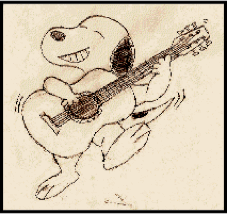Tom Poore © 2018. All rights reserved. Classical guitar lessons in Avon, Beachwood, Solon, South Euclid. Contact me at augustineregal@yahoo.com
Always remember that, for young children, the main goal is to have them enjoy the lessons and home sessions. Young children quickly lose interest in anything they don’t enjoy. And bear in mind that young children usually don’t know what goes into learning an instrument, so they may have unrealistic expectations. Also remember that children learn in their own way and time. What might look like goofing off to an adult is often just how children learn. So be patient.
For all children, bear in mind that how you approach guitar lessons will go a long way to making them a success. If your child’s guitar lessons seem important to you, then they’ll be important to your child. So you need to commit to regular lessons and regular home practice sessions. These home sessions needn’t be long. In the beginning, about ten or fifteen minutes a day is just fine for most young children. The ideal attitude is to see lessons and home practice as a special time with your child, a chance to help your child grow in accomplishment and self-confidence. If you can bring an attitude of support and enthusiasm for the guitar, then your child is more likely to respond positively.
Children up to about the age of nine shouldn’t use a full sized guitar. Children four years old probably should use a 1/4 sized guitar. For children of five to seven years of age, a 1/2 sized guitar is appropriate. Some children this age might even be able to handle a 3/4 sized guitar. For children aged nine or ten, consider a 7/8 sized guitar. Of course, these suggestions are approximations. (A good rule of thumb is that if you stand the guitar next to your child, the guitar head should be no more than about chest high.) Yamaha makes reasonably good child sized guitars. Expect to pay between $150 to $200 for a guitar and decent case.
A warning: Child sized guitars are often sold without a case. (Why guitar manufacturers do this is a mystery.) Be sure to get a good case that properly fits the guitar. A good padded zippered soft case is okay, but avoid a thin vinyl gig bag.
One more warning: Beware of overly cheap guitars. (They’re often sold at department stores.) In such guitars, the strings rattle against the frets, the intonation is hopeless, and the construction is slapdash. It might seem a good idea to buy an inexpensive guitar for a child, to see if he or she will stick with it before buying a better guitar. But cheap guitars are little better than toys, and will ruin any interest your child might have in playing the guitar.
By all means, feel free to contact me before buying a guitar. I often talk to parents before they begin their child’s first lesson. In fact, when my schedule allows, I’m happy to meet with parents of a new student to help them select a guitar. I don’t consider it an imposition. Rather, it’s a way to ensure we all get off to a good start.
Children and Guitar Lessons
“Is my child ready for guitar lessons?” This is the most common question from parents of young children (4-7 years). My honest answer is that it varies enormously from child to child. But you might consider the following questions to be a rough guide in making your decision:
• Does my child interact well with other adults?
• Can my child focus on a task for more than a few minutes at a time?
• Does my child react well to new things?
If your child is less than eight, be aware that you or some other trusted adult will need to work with your child both during lessons and at home. Young children simply can’t be expected to handle music lessons and home practice time on their own. An adult will need to sit in during lessons, quietly taking notes, and will also need to supervise your child’s practice sessions at home.

drawing by Ian Eckard
When teaching young children, a little creativity can help. Here’s one example of how I hit upon a solution to a problem:
• practice regularly
• do the best you can
• show up for your lessons
• pay on time
If you can do these things, then I’m happy to teach you to play the guitar.
Your first step to beginning lessons is to either e-mail me or give me a call. I’ll ask you a few questions about yourself, just to get an idea of where you’re starting from. I’ll also ask you about what kind of guitar you have, and what style of music you’re interested in learning. If you don’t yet have a guitar, I’ll offer suggestions. Don’t worry if you’re not sure how to answer some of my questions, since that in itself will help me know how to approach our first lesson. We’ll also discuss scheduling, to find a lesson time that works for you. I may also recommend what materials you’ll need for your first lesson. And obviously this is a good time for you to ask any questions you may have.
For most beginners, I usually recommend starting with one half-hour lesson per week.
At your first lesson, I’ll usually begin by looking over your guitar to ensure it’s in good condition. I’ll then tune it for you, and we’ll move right into learning how to hold the guitar. Depending on how well things go, you’ll learn some notes to practice at home. I try not to overwhelm beginners with too much work. At this point, I’d rather you learn a few things well than a lot of things badly. In the week after your first lesson, you can expect to practice about twenty to thirty minutes a day. (That can increase as you learn more.)
Starting with a new teacher can be disconcerting at first. In most cases, you don’t know me well, and I don’t know you well. So start by reminding yourself who’s paying whom. It’s not your job to impress me. It’s my job to help you. You should focus on doing the best you can with the time you have to practice.
As a beginner, focus on the process and don’t worry about whether you’re progressing as fast as you should. Everyone learns in their own way and time, and there’s no schedule that applies equally to everyone. Some people will learn faster than you, others slower. That’s not to say you should ignore people who progress faster than you. There’s always something to learn from them. But don’t let it discourage you. Intelligent and self-confident persistence is a powerful thing. In time, you may surpass some of those who burst out of the gate faster.
Try to be as consistent as possible with your practice time. Learning to play the guitar is like mastering a language: it’s much harder to do in fits and starts. One week of dedicated practice followed by a week of no practice isn’t the way to go. If you put in the time and good quality practice, then eventually the guitar will reward you. There are, of course, the realities of life. You have responsibilities, and sometimes other things must take priority over the guitar. But if other things constantly bump the guitar from your schedule, then you won’t get far. The guitar needs your attention, and it won’t reward being ignored.
Perhaps the best thing you can bring to learning the guitar is a commitment to an ever deeper understanding of excellence. The difference between good and bad players is often that the good player refuses to settle for mediocrity and the bad player does. If, for example, a thin and scratchy sound doesn’t bother you, then that will be your sound. But if it does bother you, then you’ll try to correct it. This can be frustrating at first. Finding flaws you can’t immediately correct may drive you crazy. But this is no cause for despair. In fact, it’s a necessary step toward getting better. You need to recognize flaws before you can go about correcting them.
I have a saying:
Beginners look at good players and say: “I wish I could play like that.”
Good players look at great players and say: “I wish I could play like that.”
Great players look at themselves and say: “I wish I could play better.”
And so it goes. This is the ultimate reality of learning to play the guitar. If you can accept it with equanimity, you’ll get far more enjoyment from your journey with music.
One last thing. Over the years, I’ve often met adults who started guitar on their own and then later got a good teacher. Every one of them wished they hadn’t delayed. Working with a good teacher saves time and cuts down on frustration. So now is the time to start. You won’t regret it.
Adult Beginners
If you’ve never played the guitar before, then guitar teachers can seem an alien breed. We use strange words when talking about music. We make playing the guitar look easy while you practice diligently just to get a few notes right. You may worry that a guitar teacher will be frustrated with how much you don’t know. Or you may suspect that after your first lesson, your teacher will giggle uncontrollably at how little you know, and then call every other guitarist in town so they also can giggle at you.
The reality, however, is that I’m delighted to take on a beginner. For me, every new student is a new challenge, and beginners can start with a clean slate. So don’t worry that you don’t know enough. After all, that’s why you’re coming to me in the first place. In fact, there are only a few things that I ask of any new student:

“I’m a student of Mr. Poore and have many wonderful comments to share about him. He is a very nice person to be around and I always look forward to going to my next guitar lesson. Mr. Poore is always having recitals, which I also look forward to; recitals strengthen your playing ability. Also, he strives to make sure his students are enjoying guitar and also making sure that they are getting better at the same time. If you are interested in taking the classical guitar and truly getting skilled at music, I would highly recommend Mr. Poore.”—Trent N. (age 12)